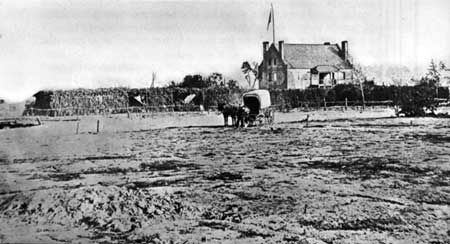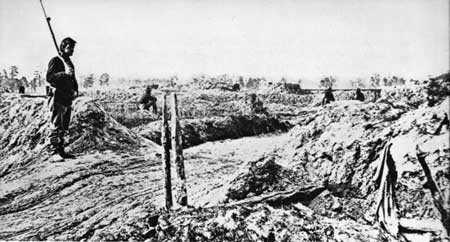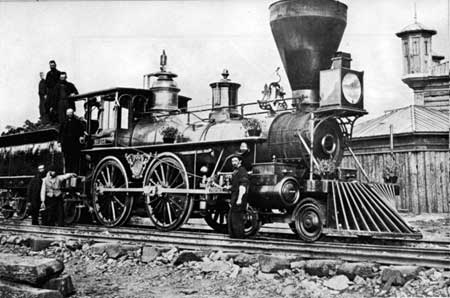|
PETERSBURG National Battlefield |
 |

Globe Tavern near the Weldon Railroad. This
building served as headquarters for the Union V Corps (Maj. Gen. G. K.
Warren) during the Battle of Globe Tavern, August 18—21,
1864.
Courtesy, National Archives.
The Fight for the Weldon Railroad
Grant, if he reviewed the fruits of his campaign shortly after July 30, could not have felt much comfort. Two hammering blows delivered against Petersburg had failed. Moreover, two important railroads still connected the city with the south. Lee, despite his numerically inferior numbers, was still able to maintain a long line of defenses around Petersburg and Richmond. Farther south, the Union outlook was brighter. Two days before the Battle of the Crater, final operations against Atlanta had been begun by Sherman. On September 2 it was to fall and the march to the sea follow.
Yet it was equally certain that Grant had accomplished an important objective. By committing Lee's weakened but still potent Army of Northern Virginia to a defensive position in the area adjacent to the Capital he was immobilizing the South's most powerful striking force. Moreover, the Union failure at the crater decided the future direction of the campaign to capture Petersburg. All Grant's energy now turned to extending siege fortifications around the city.
The first step taken in this direction after July 30 was a strong effort to capture the Weldon Railroad, which the Confederates had so nearly lost in June. On August 16, Gen. Gouverneur K. Warren, Union V Corps commander received orders to attack, occupy, and hold the Weldon Railroad 3 miles below the city.
The seizure of the objective was quickly accomplished on August 18, the opening day of battle. More than a mile of track in the vicinity of an old colonial inn named Globe Tavern was soon in Union hands. Then Warren marched most of his forces northward toward the city. Soon they were in unfamiliar and heavily wooded terrain where they encountered strong artillery and musket fire from the enemy. They then halted and bivouacked in the woods below Petersburg.
On the afternoon of the next day, August 19, four brigades of Gen. A. P. Hill's Corps struck the Union infantry. Two of the brigades man aged to slip in behind their opponents by taking advantage of the concealment offered by the heavy growth of trees. They inflicted serious losses and captured 2,700 prisoners. By nightfall Warren had been forced back a half mile nearer his new headquarters at Globe Tavern.
August 20 was marked by comparative inactivity, although there was some skirmishing in the morning. Throughout the following day Hill threw his men at the Union positions around the tavern. The attacks were in vain, for the new Union lines held. General Lee arrived with infantry replacements during the afternoon, but even this did not turn the tide of battle. By the end of the day Lee realized that the upper portion of the Weldon Railroad had been lost and that any attempt to regain it would be a needless sacrifice of manpower.

Union soldier on picket duty in the lines before
Petersburg.
Courtesy, National Archives.
One sentence from a dispatch sent by Lee to the Confederate Secretary of War on August 22 shows the seriousness of the loss of the railroad: "Our supply of corn is exhausted today, and I am informed that the small reserve in Richmond is consumed." For a time the Confederate government was able to utilize the Weldon Railroad as far as Stony Creek, 20 miles below Petersburg, where supplies were transferred to wagons and hauled around the left of the Northern Army to Petersburg and Richmond. Soon the railroad line was destroyed below Stony Creek and henceforth the beleaguered cities had only two direct rail communications with the south. These were the Richmond and Danville Railroad out of Richmond and the Southside from Petersburg.
On August 25, 4 days after the attack on Globe Tavern, the Confederates scored a minor victory with a surprise attack. Their blow was aimed at the Union II Corps which was engaged in destroying railroad tracks at Reams Station, nearly 5 miles below Globe Tavern. The II Corps, containing large numbers of inexperienced recruits, was badly beaten and more than 2,000 were taken prisoner. The Southern victory was short-lived, for the destruction of their rail communications was continued. The best that Lee could hope for in the future would be to stem the Blue advance.
In mid-September, Wade Hampton, cavalry commander of the Army of Northern Virginia, led a remarkable raid of 4,000 mounted troops around the rear of the Union Army, which now numbered 80,000. He succeeded in returning to Petersburg on September 17 with over 2,400 head of cattle and more than 300 prisoners, while suffering losses of only 61 men in two engagements with the enemy. Although this raised the morale of the Confederates, it did not change the course of the campaign. The iron band being forged outside their city was a reality, and Grant, a tenacious man, had not loosened his grip.

Photograph of one of the engines used on the United States
military railroad taken at City Point in 1865. This engine hauled men
and supplies to various parts of the long line around Petersburg.
Courtesy, National Archives.

|
|
Last Modified: Mon, Dec 2 2002 10:00:00 am PDT |


